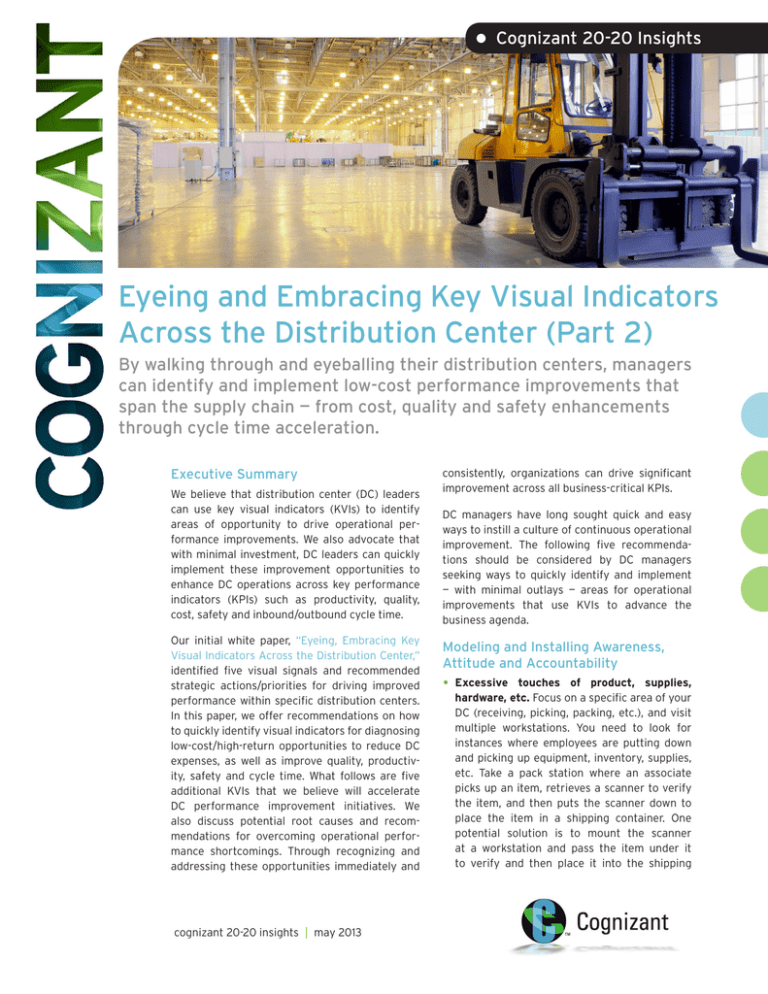
• Cognizant 20-20 Insights
Eyeing and Embracing Key Visual Indicators
Across the Distribution Center (Part 2)
By walking through and eyeballing their distribution centers, managers
can identify and implement low-cost performance improvements that
span the supply chain — from cost, quality and safety enhancements
through cycle time acceleration.
Executive Summary
We believe that distribution center (DC) leaders
can use key visual indicators (KVIs) to identify
areas of opportunity to drive operational performance improvements. We also advocate that
with minimal investment, DC leaders can quickly
implement these improvement opportunities to
enhance DC operations across key performance
indicators (KPIs) such as productivity, quality,
cost, safety and inbound/outbound cycle time.
Our initial white paper, “Eyeing, Embracing Key
Visual Indicators Across the Distribution Center,”
identified five visual signals and recommended
strategic actions/priorities for driving improved
performance within specific distribution centers.
In this paper, we offer recommendations on how
to quickly identify visual indicators for diagnosing
low-cost/high-return opportunities to reduce DC
expenses, as well as improve quality, productivity, safety and cycle time. What follows are five
additional KVIs that we believe will accelerate
DC performance improvement initiatives. We
also discuss potential root causes and recommendations for overcoming operational performance shortcomings. Through recognizing and
addressing these opportunities immediately and
cognizant 20-20 insights | may 2013
consistently, organizations can drive significant
improvement across all business-critical KPIs.
DC managers have long sought quick and easy
ways to instill a culture of continuous operational
improvement. The following five recommendations should be considered by DC managers
seeking ways to quickly identify and implement
— with minimal outlays — areas for operational
improvements that use KVIs to advance the
business agenda.
Modeling and Installing Awareness,
Attitude and Accountability
• Excessive
touches of product, supplies,
hardware, etc. Focus on a specific area of your
DC (receiving, picking, packing, etc.), and visit
multiple workstations. You need to look for
instances where employees are putting down
and picking up equipment, inventory, supplies,
etc. Take a pack station where an associate
picks up an item, retrieves a scanner to verify
the item, and then puts the scanner down to
place the item in a shipping container. One
potential solution is to mount the scanner
at a workstation and pass the item under it
to verify and then place it into the shipping
distribution center culture that starts with the
GM and cascades to front-line employees. In a
culture where safety is a focal point, the poorly
stacked pallet would have been recognized and
removed before it ever made it off the receiving
dock. If it did make it off the dock, in a building
where safety is truly part of the cultural DNA,
it would have been identified during regularly
scheduled safety walkthroughs and corrected
expeditiously.
container. For every item packed, you’ve saved
multiple seconds in productivity and improved
ergonomics at the same time. Multiplied across
hundreds of thousands or millions of units,
the impact is significant — and the cost of a
mounting bracket is minimal. If you spend the
requisite amount of time, you
find these opportunities
By modeling the will
exist in all areas of your disappropriate behavior tribution center, and often the
at the leadership simplest of fixes is the most
effective.
level, a safetyconscious attitude
will permeate your
distribution center
at all levels.
The question is “how do you create this
type of culture in your distribution center?”
The answer is by focusing on the three A’s:
awareness, attitude, and ccountability.
In well-run distribution centers,
there are procedures in place
for managers to consistently
walk-through and identify and
correct these opportunities.
This is the culture every distribution center should strive
>> Managers create awareness around safety
by integrating it into all department, shift
and facility meetings. Bulletin boards should
be used to highlight recent incidents, root
causes, prevention, etc. The board should
also track progress against safety metrics
at department, shift and facility levels. By
placing safety at the forefront of your employees’ minds, the likelihood of a safety
incident is significantly reduced.
to create.
• Delays
at the start of shift time and first
unit picked, packed and shipped. Stand in
picking, packing or shipping and measure the
amount of time between the scheduled start
of the shift time and the time you see the first
tote/carton on the conveyor from picking, the
first carton leave packing or the first carton
arrive in shipping. As a rule of thumb, anything
more than seven minutes is an opportunity to
make improvements. Potential causes could be
excessively long start-of-shift meeting times,
availability of scanners/equipment, lack of
structured workstation assignments, etc.
Opportunities for addressing this could include
setting targets for the start-of-shift meeting
times, relocating meetings closer to work
areas, pre-staging and pre-assigning scanners
prior to the start of a shift or having employees
come in early to stock workstations/supplies
and improve shift readiness. This same due
diligence and observation logic applies to postbreak-time lags also — i.e., breaks/lunches.
Shaving minutes off this time lag can result
in significant labor savings and throughput
improvements, and reduce order cycle times
with minimal investment.
>> Managers
demonstrate the attitude that
they expect from their associates. Pick up
debris, do not pass by an unsafe condition
without correcting it and truly listen to and
act upon employee suggestions and concerns around safety. By modeling the appropriate behavior at the leadership level,
a safety-conscious attitude will permeate
your distribution center at all levels.
>> Managers must hold themselves and their
employees accountable for ignoring or
violating established safety procedures.
Without accountability, procedures become
nothing more than empty words on a piece
of paper.
• Do
employees understand their targets
and do they know how they are progressing against those targets? As you walk the
distribution center floor, ask random folks
in multiple departments if they know what
their performance goal/target is, and if so ask
them how they are performing against that
target. In well-run distribution centers, there
is a clear understanding of established goals
at individual, department and facility levels.
There are also multiple mechanisms in place
to communicate progress against established
goals as close to real time as possible. Performance communication and feedback are
critical components of well-run distribution
• Reserve
racks with poorly stacked pallets,
shrink-wrap dangling, empty boxes in
locations, etc. All of these conditions are
symptomatic of a lack of focus on safety by
unloaders, equipment operators, cycle count
associates and anyone else within the process
flow from the receiving dock to the reserve
rack. Safety is a mindset and a byproduct of a
cognizant 20-20 insights
2
Supervisor KVI Quick-Check Assessment Tool
Do associates have
excessive touches of product,
supplies, hardware?
Potential causes could be:
• Excessively long start-of-shift meeting times.
• Nonavailability of scanners/equipment.
• Lack of structured workstation assignments.
Opportunities could include:
• Setting targets for start-of-shift meeting times.
• Relocating meetings closer to work areas.
• Pre-staging and pre-assigning scanners
prior to start of shift.
• Utilizing employees to come in early to stock
workstations/supplies and improve shift readiness.
YES
Reduce the touch points
to improve productivity
and ergonomics.
YES
Identify the potential
causes and correct them.
YES
STOP! All of these are
symptomatic of a lack of focus
on safety by associates.
NO
Create mechanisms to
communicate targets and
provide feedback.
NO
It means there are
opportunities that could lead
to increase in throughput,
productivity and cycle time.
NO
Is the time between start of shift time
and first unit picked, packed, shipped
time more than seven minutes?
NO
Are there reserve racks with poorly
stacked pallets, shrink-wrap dangling
or empty boxes in locations in the DC?
Create a culture in DC that focuses on
safety by focusing on the three A’s:
• Awareness.
• Attitude.
• Accountability.
NO
Do employees understand their
targets and do they know how they are
progressing against those targets?
YES
Are people moving with
a sense of urgency and a pace
indicative of time pressure?
Opportunities include:
• Leadership modeling.
• Setting clear and aggressive goals.
• Consistent performance feedback.
YES
WELL DONE!
Figure 1
centers. In the absence of this, employees are
unaware of where/what the target is and how
they are progressing against it. It is analogous
to throwing darts at a wall, then placing the
dart board on the wall afterwards to see how
you did. There is no awareness of where to aim,
and no knowledge of how you did until it’s too
late to react.
• Are people moving with a sense of urgency
and a pace indicative of time pressure? Fast
pace is one of those qualitative terms that
10 people may define 10 different ways. One
indication of this is when you walk into the distribution center; do folks move the way people
move in an airport when they are trying to
catch a flight? They walk with purpose and are
very focused on both the task at hand and their
surroundings.
By creating mechanisms to communicate
targets and provide feedback, managers can
foster a culture of awareness and accountability. Strong performers can receive positive
feedback, marginal performers can utilize
that “next gear” to bring performance up and
underperformers can be coached/trained to
bring their work up to target. The net result
of this is a more motivated and knowledgeable workforce, and a distribution center
that has higher productivity, lower cost-perunit, reduced order cycle time and increased
employee morale.
cognizant 20-20 insights
Pace is critical in a distribution center, as
every step and every second matter in terms
of throughput, productivity and cycle time.
There are multiple causes and cures for pace
issues. One of the primary causes of poor
pace is leadership modeling. If your leaders
demonstrate poor pace, it is likely their subordinates will model that behavior. The second
cause is lack of clear and aggressive goals and
consistent performance feedback. If people do
not understand their targets and do not know
3
how they are progressing against them it can
reduce motivation, and sometimes result in
demotivation.
Also, the goals need to be
A target DC pace is aggressive enough to elicit
the appropriate pace from
analogous to a target your employees. A target
heart rate during DC pace is analogous to
exercise. Too low and a target heart rate during
exercise. Too low and you’re
you’re not working not working hard enough.
hard enough. Too Too high and you’re going
high and you’re going to burn out and fail. The
sweet spot is somewhere in
to burn out and fail. the middle that pushes you
forward but doesn’t knock
you down. Another potential cure for pace
issues is to recognize the behavior you want
to demonstrate. In other words, “catch people
doing something right” in terms of pace and
recognize/reward that effort consistently and
publicly. Human nature is to want to feel that
what you do has meaning, and that your hard
work is recognized and appreciated. Do this
enough, and the positive vibe and pace implications will become contagious and infect your
DC in a very positive way.
Running Better, Running Different
This paper has identified five additional focus
areas for your DC to continue embracing KVIs in
conjunction with KPIs to drive world-class performance. These are simple, low-cost and immediate
impact areas that will yield tangible benefits in
productivity, cost, safety, order cycle time and
employee engagement.
If you are considering delaying or waiting until
the time is right to take action, just remember
your competitors probably are not. We have been
in distribution centers where visual recognition is
a part of the DNA, and have seen first-hand the
positive results that can be achieved by recognizing opportunities and implementing the suggestions contained in this paper. By acting immediately and consistently, organizations can achieve
better margins through increased productivity and reduced cost, and reap higher accuracy
rates and better customer service levels through
improved accountability and awareness, which
will help your organization compete in a world
where customers continue to demand product
faster, cheaper, more accurately and on time,
every time.
About the Author
John Lowe is a Senior Manager within Cognizant Business Consulting’s Retail Practice. He is responsible
for advising on logistics and supply chain management projects across multiple Fortune 100 clients.
He previously led DC operations for numerous Fortune 500 organizations, including Amazon.com, TJX,
Gap, Inc. and Rockwell Automation. John received his M.B.A. from the University of Illinois at UrbanaChampaign. He can be reached at John.Lowe@cognizant.com.
About Cognizant
Cognizant (NASDAQ: CTSH) is a leading provider of information technology, consulting, and business process outsourcing services, dedicated to helping the world’s leading companies build stronger businesses. Headquartered in
Teaneck, New Jersey (U.S.), Cognizant combines a passion for client satisfaction, technology innovation, deep industry
and business process expertise, and a global, collaborative workforce that embodies the future of work. With over 50
delivery centers worldwide and approximately 156,700 employees as of December 31, 2012, Cognizant is a member of
the NASDAQ-100, the S&P 500, the Forbes Global 2000, and the Fortune 500 and is ranked among the top performing
and fastest growing companies in the world. Visit us online at www.cognizant.com or follow us on Twitter: Cognizant.
World Headquarters
European Headquarters
India Operations Headquarters
500 Frank W. Burr Blvd.
Teaneck, NJ 07666 USA
Phone: +1 201 801 0233
Fax: +1 201 801 0243
Toll Free: +1 888 937 3277
Email: inquiry@cognizant.com
1 Kingdom Street
Paddington Central
London W2 6BD
Phone: +44 (0) 20 7297 7600
Fax: +44 (0) 20 7121 0102
Email: infouk@cognizant.com
#5/535, Old Mahabalipuram Road
Okkiyam Pettai, Thoraipakkam
Chennai, 600 096 India
Phone: +91 (0) 44 4209 6000
Fax: +91 (0) 44 4209 6060
Email: inquiryindia@cognizant.com
­­© Copyright 2013, Cognizant. All rights reserved. No part of this document may be reproduced, stored in a retrieval system, transmitted in any form or by any
means, electronic, mechanical, photocopying, recording, or otherwise, without the express written permission from Cognizant. The information contained herein is
subject to change without notice. All other trademarks mentioned herein are the property of their respective owners.


